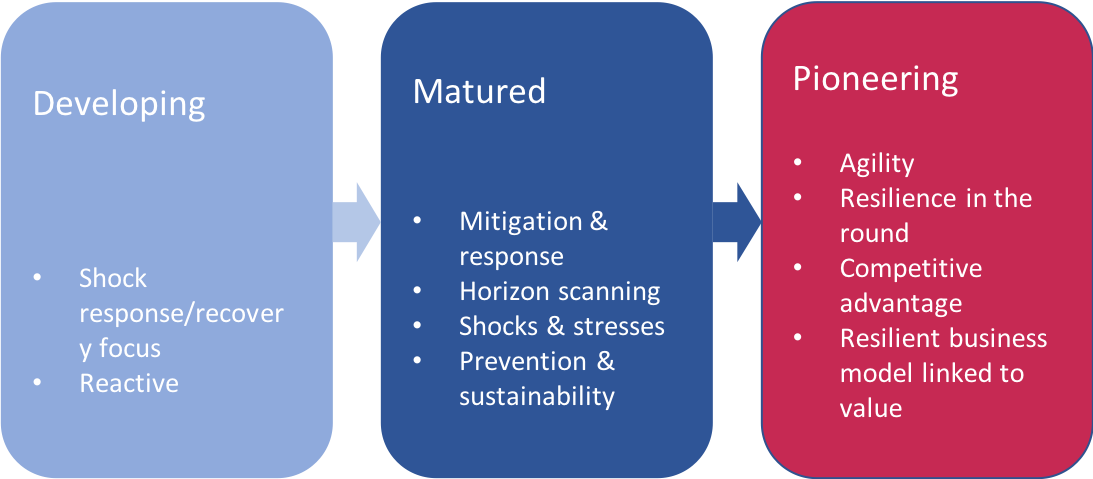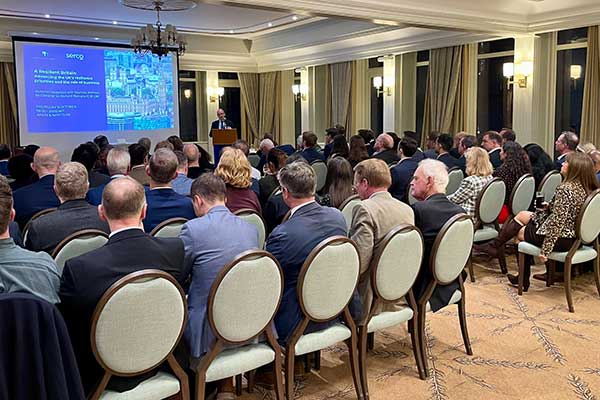Our latest briefing event looked at the role of standards in driving awareness and behaviours in resilience.
Hosted by The Resilience Shift, our latest founder champion, the briefing looked at how standards are being developed for both public and private sector activity.
Public sector
Dr Rob MacFarlane, Deputy Director of the Civil Contingencies Secretariat (CCS) at the Cabinet Office, took members through what ‘good’ looks like in multi-agency resilience capabilities.
The basis of the CCS’s work is the Civil Contingencies Act (2004) which considers two categories of responders to an emergency: Cat 1, which are local authorities, hospitals and blue-light services, and Cat 2, mostly utility companies and transport organisations. These are expected to work together to respond to an incident, depending on the circumstances.
The CCS defines capability as ‘a demonstrable ability to do something, to defined levels, under specified circumstances’ and this has four components:
- Physical – equipment, infrastructure, logistics and supplies
- Organisational – legislation, regulations, information and communications
- Intellectual – plans and procedures, doctrines, standards and lessons
- Human – people and their skills, training and education.
Rob outlined three ways to articulate what good looks like in resilience: targets, guidance and activities.
Targets state ‘this is what good is’. Guidance sets out a process that if followed, will achieve ‘good’. Activities are what is good in practice: what are practitioners doing that works, what is the local learning and innovations, and how can this best be shared for others to emulate.
The principle of integrated emergency management as a cycle: anticipate – assess – prevent – prepare – respond – recover – has been revised to include validation and learning at key points.

This is about assuring that plans and preparations are deliverable and likely to work, and learning from incidents to improve a future response.
As set out in the National Security Capability Review, a set of 12 standards have been developed for local resilience to work towards.
These are concise – no more than two sides of A4 for each – and cover what responders must do, should do, and may want to consider doing.
Nine topics have been published so far, including risk assessment and communications, training and exercising, and business continuity.
They provide a yardstick to measure preparedness and also a means for continual improvement.
Three more standards on pandemic flu, cyber, and community resilience are in consultation, while others on flooding, counter-terrorism, mass fatalities and CBRN are in development.
Challenges remain: including moving from outputs ‘ we have…’ to outcomes ‘we can do…’, and also moving from evidencing or assuring that a capability exists, to actual readiness to respond.
The standards are available at Resilience Direct (registered users only): see this Cabinet Office information for more details on accessing the site.
Private sector
Caroline Field, Head of Resilience at Thornton Tomasetti, spoke about the City Resilience Standard BS67000, as the chair of committee that is developing the standard.
City resilience is important: 70% of the world’s population will live in cities by 2050. Three-quarters of the world’s energy is consumed in cities, and they produce 80% of greenhouse gasses.
In developing a standard for city resilience, the committee considered how resilience would help a city achieve its strategic ambitions, and thrive rather than just survive.
The standard has been developed by a diverse group of consultants, city representatives, government officials, agencies, infrastructure providers and academia, and provides practical guidance and tools.
It builds on the growing portfolio of guidance available and is intended for use by all stakeholders who contribute to a city’s life.
Caroline outlined the changing perspective of resilience, from developing (reactive to events) to matured (horizon scanning, prevention and sustainability) to pioneering (agile, resilience in the round).

She outlined the five fundamental qualities of a city’s planning for resilience and cited a global example of each:
- Inclusive: community cohesion and quality of life for all. When Chicago was experiencing severe heat, poorer communities were more cohesive than better off communities.
- Durable: long-term thinking. New York has responded to Hurricane Sandy by building flood defences that also provide high quality recreational areas when not in use, improving quality of life for local people
- Reflective: learning and evidencing. Instead of using a space for more retail or offices, Canary Wharf created a rooftop greenhouse garden to create a more appealing destination for the people it wants to attract.
- Adaptive: agile and able to change. Singapore gave an area of land with complete flexibility of use to its master developers to create a new part of the city that would deliver a series of outcomes over a number of years.
- Integrated: working together, solving multiple problems. Beirut overhauled its city resilience governance to ensure the right people were at the table and actions could be prioritised and measured, such as air quality.
The standard provides a framework to organise, assesses, plan, deliver and continuously improve resilience, ultimately allowing for an evaluation of the maturity of a city’s resilience.

For further reading, please visit our Knowledge Hub.



